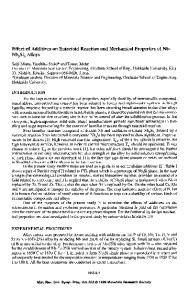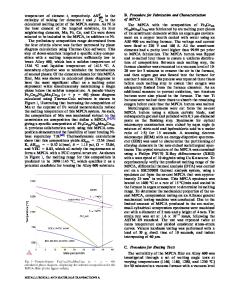Microstructure and Mechanical Properties of Vacuum Brazed Nb SS /Nb 5 Si 3 Composite Joints Using Ni-Based Filler Alloys
- PDF / 5,979,197 Bytes
- 10 Pages / 593.972 x 792 pts Page_size
- 94 Downloads / 384 Views
ON
WITH the development of aviation industry, severe requirements are put forward for the existing hightemperature structural materials.[1] To improve the thrust of the turbine system and reduce emissions, higher turbine inlet temperature is demanded, which currently depends on the temperature capacity of turbine blades made of Ni-based superalloys exclusively.[2,3] However, in general the limited service temperature of the current Ni-based single crystal superalloys is less than 1423 K. NbSS/Nb5Si3 in situ composite material is one of the potential high-temperature structural material candidates because of its excellent properties such as high-melting point, low density and attractive high temperature mechanical properties. The potential service temperature of NbSS/ Nb5Si3 composite can reach 1473-1673 K and it is very promising to replace the existing nickel-based superalloys.[4,5] One major drawback of niobium silicides is the low fracture toughness at room temperature, which X.Y. REN, H.P. XIONG, C. PEI, B. CHEN, and Y.Y. CHENG are with the Welding and Plastic Forming Division, Beijing Institute of Aeronautical Materials, Beijing 100095, P.R. China. Contact e-mail: [email protected], [email protected] Y.W. KANG is with the Science and Technology on Advanced High Temperature Structural Materials Laboratory, Beijing Institute of Aeronautical Materials, Beijing 100095, P.R. China. Manuscript submitted June 3, 2019.
METALLURGICAL AND MATERIALS TRANSACTIONS A
seriously restricts its application.[6] To obtain a hightemperature structural material with balanced mechanical properties including room temperature toughness and high-temperature mechanical strength, dual-phase Nb-Si alloys consisting of the ductile Nb phase and the stiffening Nb5Si3 silicide was studied based on the phase diagram.[7] Recently, the fabrication techniques and the mechanical properties of NbSS/Nb5Si3 composite have been extensively reported,[8–13] and the involved techniques include vacuum arc melting,[7,10] directional solidification,[6] hot pressing sintering,[5,9] self-propagating hightemperature synthesis (SHS)[8] and powder metallurgy technology.[3] To realize its practical engineering applications, undoubtedly, joining of NbSS/Nb5Si3 composite will be an extremely important processing technology in future, especially for the aeroengine blades fabricated by NbSS/ Nb5Si3 composite with complicated inner cooling tunnels. Due to its high-melting temperature of higher than 1973 K together with the eutectic microstructure of Nb solid solution and Nb5Si3 intermetallic compound,[5] it is difficult to achieve reliable joining of this refractory material. So far, the research on joining technology of NbSS/Nb5Si3 composite and the basic understanding of the joining problem have been seriously lacking. For the brazing technique, traditional Ni-based filler alloys are widely used for joining of high-temperature structure materials such as stainless steels, Ni-based superalloys including single-crystal superalloys, and even ceramic materials. Recentl
Data Loading...











